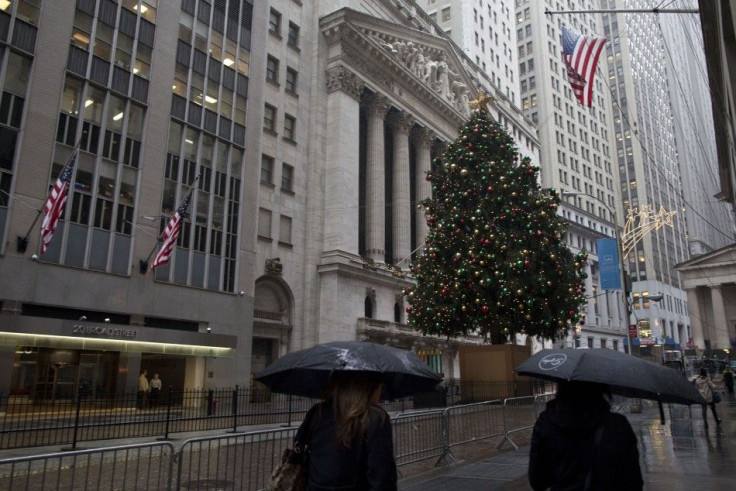Morgan Stanley's Job Cuts Only Latest in Wave of Firings at the Heart of Wall Street
Payroll carnage on Wall Street no longer limited to back office and European outfits; JP Morgan, Goldamn Sachs last holdouts

The tree in front of the New York Stock Exchange is there, along with the unlit Hanukkah chandelier and a separate monument commemorating Kwanzaa. The Hermès store right across from the stock market site is decked out in its cheeriest holiday display, as are the windows at Tiffany's a stone's throw away.
Yet behind this cheery façade, the New York high-finance sector seems to be getting nothing but lumps of coal this holiday season, as mass layoffs and disappointing year-end bonus announcements have been the order of the day since shortly after Thanksgiving. On Wall Street, it's NOT beginning to look a lot like Christmas.
Morgan Stanley's (NYSE:MS) plan to cut about 1,600 jobs globally in the first quarter of 2012, which was confirmed earlier today by a bank spokeperson, is only the latest in a round of payroll-purging going through the nation's largest financial institutions. On Monday for example, Fox Business News reported that embattled investment bank Jefferies & Co. (NYSE:JEF) was preparing to slash 11 percent of its total workforce.
The cuts at Morgan Stanley, amounting to 2.6 percent of the total payroll there, also comes after layoffs of 4,500 at Citigroup (NYSE:C), which were announced Dec. 6, the same day Bank of America (NYSE:BAC) confirmed it had already started firing people as part of a wider previously-announced plan to get rid of 30,000 employees "over several years."
Banks have been firing employees all year. Reuters estimates 120,000 people in the global financial services industry have gotten the axe this year. But this time, in what could be called Wall Street's winter of discontent, things are different.
A large amount of the worker exodus earlier in the year had specifically affected European banks, who had responded to the Continent's financial crisis with "bloodletting" in their equities desks and brokerage divisions. But the carnage isn't over, as early-December announcements from French giants Crédit Agricole and Société Générale show.
By comparison, American banks appeared to be doing all they could to decrease costs without disposing of their crown jewel divisions. Banks like Wells Fargo & Co. (NYSE:WFC) and Goldman Sachs (NYSE:GS) had been busy trimming the edges of their operations, getting rid of people in the IT department and cutting back on non-vital costs, down to axing the landscapers who were watering potted plants at the firm's headquarters. The most recent cuts, however, strike at the heart of the bank's business, letting people like bankers, fixed income strategists and research analysts -- many of whom were thought of a priceless "talent" only a few years ago -- walk out the door.
Some bank analysts had called it. Back in early November, when Bank of America was beginning to go about the thankless task of letting 30,000 people go, Richard Bove, a bank industry analyst for Rochdale Securities, told TheStreet.com that the ancillary employees in infrastructure support "always get cut back when you're reducing the size of an entity in trouble" bu that "that's not where they're going to get the big savings in people. It's getting rid of the whole foreclosure group, selling business lines. That's how you really cut people effectively, not taking 10% of the people who work in the mailroom."
Perhaps as disconcerting as the layoffs (at least for the ones staying behind) bonuses and promotions are also getting put on ice. Merrill Lynch investment advisers, for example, were reportedly "fuming" Wednesday after being told their bonuses for this year would be substantially less than expected. (A compensation study out late November estimated bonuses across the industry would be off by 30 percent, on average, when compared to last year). Goldman Sachs also made headlines earlier by announcing it had seen the highest number of partners since 2008 -- 38 of them -- leave the company, in the same year it had sharply cut the number of people it had promoted to managing director.
Common sense on the Street says the two developments, reduced bonuses and increased firings, go hand-in-hand due to a bad economic environment for banks. But at least one bank analyst has gone further, saying one event is directly causing the other.
Back in June, Kian Abouhossein, an analyst for JP Morgan Chase (NYSE:JPM) told Crain's New York Business the banks had painted themselves into a cost structure that would require "material staff cuts," as the scaling-back of bonuses that went on as a response to public outrage in 2009 meant some banks were now paying higher base pay, a strategic blunder that could not be easily reversed.
Abouhossein's own JP Morgan and, arguably, Goldman Sachs, seem to be the last of the major American banks yet to announce any massive layoffs. While JP Morgan is reportedly trying its best to buck the trend and avoid a hurricane of pink slips, the market, as always will have the final say.
Deutsche Bank large-cap bank analyst Matt O'Connor recently said that if the banks' revenue picture does not improve, additional cost-cutting of up to 10 percent might be required across the board.
Ten percent is a lot of pink, and pink is not a Christmas color.
© Copyright IBTimes 2024. All rights reserved.











